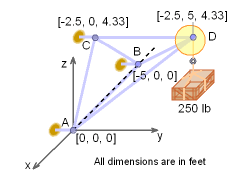| Ch 6. Structures | Multimedia Engineering Statics | ||||||
| 2-D Trusses: Joints | 2-D Trusses: Sections | 3-D Trusses | Frames and Machines | ||||
| 3-D Trusses/Space Trusses | Case Intro | Theory | Case Solution | Example |
| Chapter |
| 1. Basics |
| 2. Vectors |
| 3. Forces |
| 4. Moments |
| 5. Rigid Bodies |
| 6. Structures |
| 7. Centroids/Inertia |
| 8. Internal Loads |
| 9. Friction |
| 10. Work & Energy |
| Appendix |
| Basic Math |
| Units |
| Sections |
| eBooks |
| Dynamics |
| Fluids |
| Math |
| Mechanics |
| Statics |
| Thermodynamics |
| ©Kurt Gramoll |
| STATICS- EXAMPLE |
||
| Example |
||
|
|
Determine the force in the member CD, BD and AD of the space truss shown in the figure. Note that points A, B and C are in the x-z plane and member CD is parallel to y-axis. |
|
| Solution |
||
|
|
First, the co-ordinates of joints A, B, C and D need to be found. From the figure it can be seen that ΔABC is an equilateral triangle with each side of 5 feet. The height of the equilateral triangle will be equal to 5 cos30o, or 4.330 feet. Thus, the coordinates each joint will be, A = [0, 0, 0] B = [-5, 0, 0] C = [-2.5, 0, 4.33] D = [-2.5, 5, 4.33] Since, there are only three unknown forces at joint D, the force analysis of the truss will begin at joint D. Recall, with 3D trusses, three equations can be used at each joint. |
|
 |
Let the force in member AD, BD and CD be labeled as FAD, FBD and FCD respectively. Expressing each force acting at joint D in the vector notation gives, W = -250 k All forces have to be in equilibrium, giving ΣF = 0 | |
Equating the i, j and k components gives, ΣFx = 0 ΣFz = 0 ΣFy = 0 Members AD and BD are in tension and member CD is in compression. |
||

